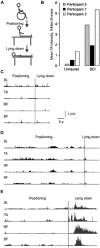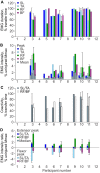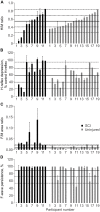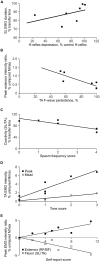Characterization of Involuntary Contractions after Spinal Cord Injury Reveals Associations between Physiological and Self-Reported Measures of Spasticity
- PMID: 28232792
- PMCID: PMC5299008
- DOI: 10.3389/fnint.2017.00002
Characterization of Involuntary Contractions after Spinal Cord Injury Reveals Associations between Physiological and Self-Reported Measures of Spasticity
Abstract
Correlations between physiological, clinical and self-reported assessments of spasticity are often weak. Our aims were to quantify functional, self-reported and physiological indices of spasticity in individuals with thoracic spinal cord injury (SCI; 3 women, 9 men; 19-52 years), and to compare the strength and direction of associations between these measures. The functional measure we introduced involved recording involuntary electromyographic activity during a transfer from wheelchair to bed which is a daily task necessary for function. High soleus (SL) and tibialis anterior (TA) F-wave/M-wave area ratios were the only physiological measures that distinguished injured participants from the uninjured (6 women, 13 men, 19-67 years). Hyporeflexia (decreased SL H/M ratio) was unexpectedly present in older participants after injury. During transfers, the duration and intensity of involuntary electromyographic activity varied across muscles and participants, but coactivity was common. Wide inter-participant variability was seen for self-reported spasm frequency, severity, pain and interference with function, as well as tone (resistance to imposed joint movement). Our recordings of involuntary electromyographic activity during transfers provided evidence of significant associations between physiological and self-reported measures of spasticity. Reduced low frequency H-reflex depression in SL and high F-wave/M-wave area ratios in TA, physiological indicators of reduced inhibition and greater motoneuron excitability, respectively, were associated with long duration SL and biceps femoris (BF) electromyographic activity during transfers. In turn, participants reported high spasm frequency when transfers involved short duration TA EMG, decreased co-activation between SL and TA, as well as between rectus femoris (RF) vs. BF. Thus, the duration of muscle activity and/or the time of agonist-antagonist muscle coactivity may be used by injured individuals to count spasms. Intense electromyographic activity and high tone related closely (possibly from joint stabilization), while intense electromyographic activity in one muscle of an agonist-antagonist pair (especially in TA vs. SL, and RF vs. BF) likely induced joint movement and was associated with severe spasms. These data support the idea that individuals with SCI describe their spasticity by both the duration and intensity of involuntary agonist-antagonist muscle coactivity during everyday tasks.
Keywords: F-wave; H-reflex; muscle co-activation; muscle spasms; tone; wheelchair transfer.
Figures







Similar articles
-
Impact of spasticity on transfers and activities of daily living in individuals with spinal cord injury.J Spinal Cord Med. 2019 May;42(3):318-327. doi: 10.1080/10790268.2017.1400727. Epub 2018 Jan 15. J Spinal Cord Med. 2019. PMID: 29334339 Free PMC article.
-
Differential control of reciprocal inhibition during walking versus postural and voluntary motor tasks in humans.J Neurophysiol. 1997 Jul;78(1):429-38. doi: 10.1152/jn.1997.78.1.429. J Neurophysiol. 1997. PMID: 9242291 Clinical Trial.
-
Abnormal cutaneous flexor reflex activity during controlled isometric plantarflexion in human spinal cord injury spasticity syndrome.Spinal Cord. 2016 Sep;54(9):687-94. doi: 10.1038/sc.2016.9. Epub 2016 Feb 23. Spinal Cord. 2016. PMID: 26902460
-
Contributions to the understanding of gait control.Dan Med J. 2014 Apr;61(4):B4823. Dan Med J. 2014. PMID: 24814597 Review.
-
Neural adaptations to resistive exercise: mechanisms and recommendations for training practices.Sports Med. 2006;36(2):133-49. doi: 10.2165/00007256-200636020-00004. Sports Med. 2006. PMID: 16464122 Review.
Cited by
-
Assessment of quality of life in relation to spasticity severity and socio-demographic and clinical factors among patients with spinal cord injury.J Spinal Cord Med. 2020 Mar;43(2):193-200. doi: 10.1080/10790268.2018.1543093. Epub 2018 Dec 3. J Spinal Cord Med. 2020. PMID: 30508404 Free PMC article.
-
A scoping review on muscle cramps and spasms in upper motor neuron disorder-two sides of the same coin?Front Neurol. 2024 Mar 1;15:1360521. doi: 10.3389/fneur.2024.1360521. eCollection 2024. Front Neurol. 2024. PMID: 38497037 Free PMC article.
-
Vibration attenuates spasm-like activity in humans with spinal cord injury.J Physiol. 2020 Jul;598(13):2703-2717. doi: 10.1113/JP279478. Epub 2020 Jun 10. J Physiol. 2020. PMID: 32298483 Free PMC article.
-
Impact of spasticity on transfers and activities of daily living in individuals with spinal cord injury.J Spinal Cord Med. 2019 May;42(3):318-327. doi: 10.1080/10790268.2017.1400727. Epub 2018 Jan 15. J Spinal Cord Med. 2019. PMID: 29334339 Free PMC article.
-
Accuracy and Reliability of Single-Camera Measurements of Ankle Clonus and Quadriceps Hyperreflexia.Arch Rehabil Res Clin Transl. 2021 Aug 19;3(4):100153. doi: 10.1016/j.arrct.2021.100153. eCollection 2021 Dec. Arch Rehabil Res Clin Transl. 2021. PMID: 34977536 Free PMC article.
References
LinkOut - more resources
Full Text Sources
Other Literature Sources
Miscellaneous

